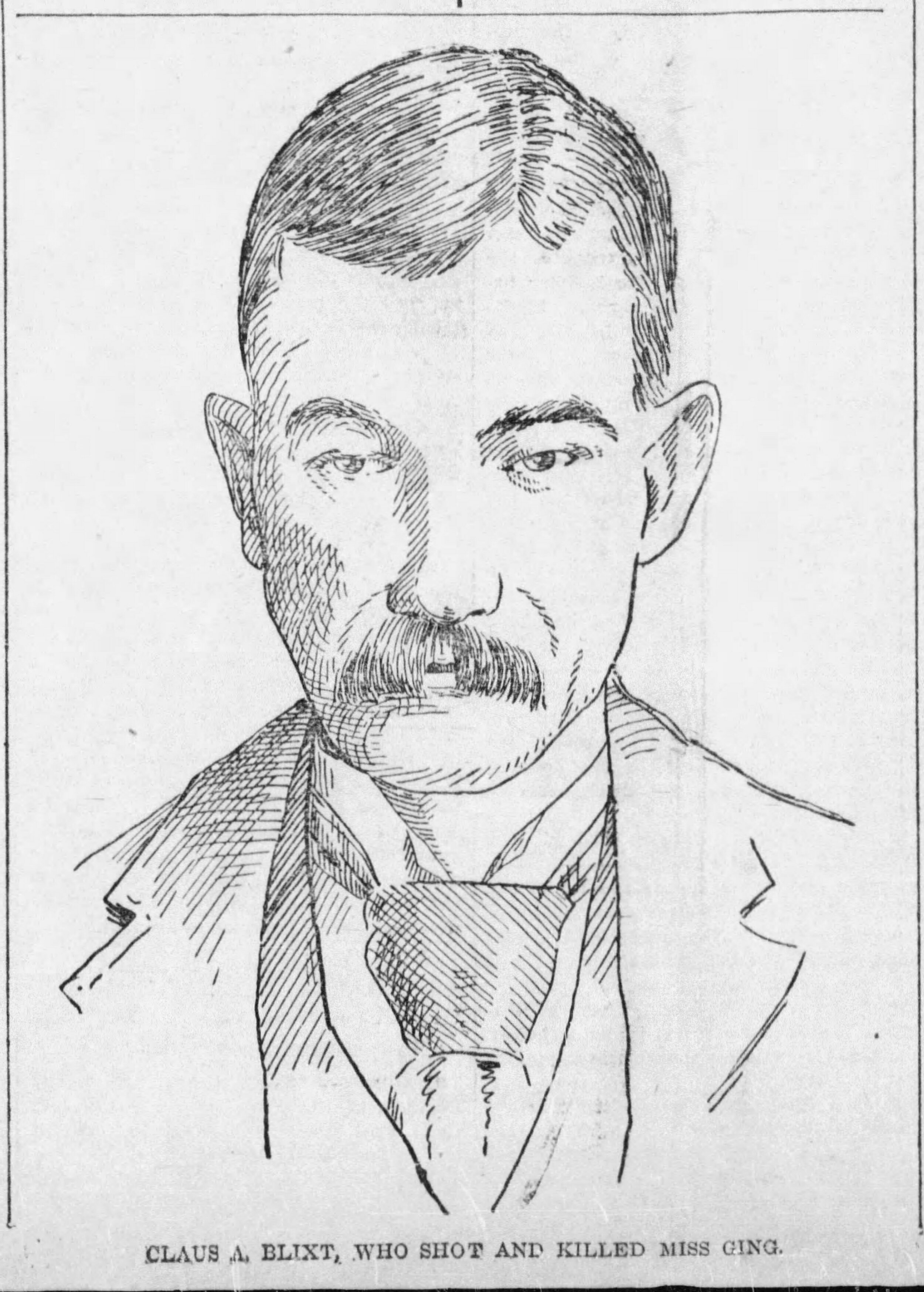Episode 26: Minneapolis Svengali
Minneapolis Svengali
Harry T. Hayward
Harry T. Hayward was suave, sophisticated, and wealthy. He didn’t take life too seriously, preferring gambling to work. But Harry had a dark side, and he used his charms to captivate those around him to do his will. So, when it was discovered that he was behind the murder of Kitty Ging, he went on trial. His accomplice, Claus Blixt, and others testified that Hayward must have hypnotized them to do his will.
Listen to our latest episode as we discuss the murder Harry T. Hayward arranged, his later confession to his cousin, and what happened to his family after his death. Then continue listening as we explore a tree that goes back to the Mayflower, New Netherland, a murdered family member, and how a member of his family was tied to the Springfield Race Riot of 1908.
Katherine Mary Ging (1864-1894), murder victim of Harry T. Hayward and Claus Blixt.
A drawing of the scene of the crime.
Source: The Minneapolis Star-Tribune, 9 Mar 1895
Source: The Minneapolis Star-Tribune, 9 Mar 1895
Harry T. Hayward (1865-1895), the Minneapolis Svengali
Hayward’s passport application, dated 1892.
Hayward convinced Claux Blixt (1853-1925), one of his father’s employees, to carry out the murder of Catherine. After his trial, he would spend the remainder of his life in Stillwater Prison.
Source: The Minneapolis Star-Tribune, 9 Mar 1895
Photograph of Hayward not long before his execution.
Ozark Flats apartment building where Kitty lived at 1229 Hennepin Avenue, Minneapolis.
The scaffolding where Hayward was hanged on 11 December 1895.
Adry Allen Hayward (1861-1920) was initially arrested with brother Harry, but was released once he told the police everything he knew. Adry was just one of Harry’s brother's.
Literary character, Dietrich Knickerbocker, created by author Washington Irving. Adry Hayward’s wife Charlotte Knickerbocker Chamberlain, was the granddaughter of Herman Knickerbocker, a former U.S. Congressman. He was a good friend of Washington Irving who “borrowed” Knickerbocker’s name for the character.
The very exclusive gentleman’s club, active since 1871, The Knickerbocker Club.
Source: Wikimedia
William W. Hayward (1834-1915) with wife Lodusky Lovingsky Loper (1836-1903.
Source: Find a Grave
The will of Captain Daniel Tolman, Hayward’s paternal great-grandfather.
Depiction of the signing of the Mayflower Compact by artist Jean Leon Gerome Ferris in 1899. It was signed by three of Hayward’s ancestors.
John and Elizabeth (Tilley) Howland house, built in 1666 in Plymouth, Massachusetts. Photo taken in 1921. Today, the house is a historic museum, available to tour.
An early picture of the Loper family, taken in Illinois before 1868. While Hayward’s mother isn’t picture, two of the people discussed in the episode are. Front row (left to right): Leni, Gideon, and Darlusky; Back row (left to right) Ophelia, Cruce, and Adrianna.
Adrian Loper (sitting) with sons Gideon, left, and Cruce.
The man responsible for the death of Darlusky Loper, her brother-in-law William Sherman
Hayward’s uncle, Gideon Blackburn Loper
Hayward’s maternal grandfather, Adrian Woodruff Loper (1815-1890)
Maternal grandmother of Hayward, Susan Jeffers Keller Loper (1818-1896, wife of Adrian Loper.
Harry T. Loper at the wheel of his automobile, surrounded by friends. Likely the same vehicles used to transport George Richardson and Joe James to Bloomington, Illinois.
Source: Sangamon County Historical Society
William Donegan was one of two Black men lynched during the Springfield Race Riot of 1908.
Scott Burton was the other Black man lynched during the “riot.” I’ve been unable to find a photo or drawing of him.
To see even more documents and photographs/drawings related to this episode and past episodes, consider becoming a Patron.
ADDITIONAL INFORMATION
DISCLOSURE: Murderous Roots is listener-supported. Some of the links below include Amazon affiliate links that may bring us a small commission to help support the podcast, at no additional cost to you.
Books mentioned in the episode
Trilby by George du Maurier
Harry Hayward by Edward Goodsell [The confession of Harry to his cousin Edward]
A History of New York from the Beginning of the World to the End of the Dutch Dynasty by Washington Irving
Memoirs of Roger Clap by Roger Clap
Other related texts
The Infamous Harry T. Hayward by Shawn Francis Peters
Mayflower: Voyage, Community, War by Nathaniel Philbrick
Elizabeth Packard: A Noble Fight by Linda Carlisle
SOURCES
Harry T. Hayward: Socialite, Arsonist, and Murderer
Big Apple Secrets: The oldest private club in New York
Scandinavian Immigrants in New York, 1630-1674 by John O. Evjen
Harry T. Loper’s Difficult Day
Captain Roger Clapp
Loper-Keller-VanMeter & Allied Lines by Melba Wood
Portrait & Biographical Record of Macoupin County
Wikipedia
We use a multitude of resources when researching a family tree up to an including census records from 1800-1940, marriage records in various states, draft registration cards, newspaper articles, and more. If you would like more specific details on where information was obtained, please email us and we’ll respond in a timely manner.





















